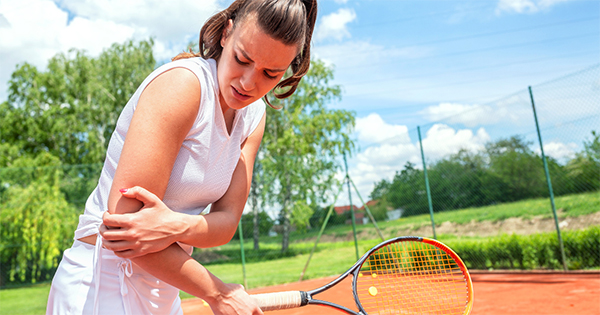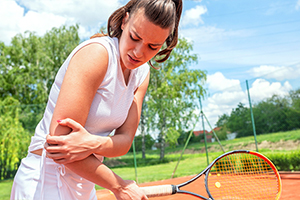
Athletes of all levels – including professional, amateur, and recreational athletes – know there’s nothing worse than suffering a sports injury. Sports injuries are prevalent across all sports, from high-impact competition like football, hockey, and combat sports, to lower-impact sports like golf, hiking, rowing, and cycling. Not only are the most common sports injuries painful, but they can also be highly debilitating and disruptive, keeping you sidelined and away from the activities you love.
If you think you may have a sports injury, early recognition and proper treatment are critical for avoiding long-term complications.
So, whether you’re an athlete or fitness enthusiast yourself, or a parent or coach caring for the athletes in your life, it’s important to know the signs, symptoms, prevention tips, and treatment options for the most common sports injuries.
Here’s how to manage the four most common sports injuries, so you can get back in the game.
Sprains and Strains:
Sprains and strains are some of the most common sports injuries, and can happen whether you’re actively engaged in an intense activity, or simply going for a walk. They can happen suddenly and without warning, or develop slowly over time. Whatever the cause, they’re always unpleasant, whenever and wherever they occur. You have probably heard about sprains and strains, but may wonder what they are, exactly.
A sprain is a stretched or torn ligament (tissues that connect bones at a joint). Ankle and wrist sprains are common, so watch for symptoms like pain, swelling, bruising, or the inability to comfortably move those areas.
A strain is a stretched or torn tendon (tissues that connect muscle to bone). Hamstring and back strains are the most common, so be on the lookout for symptoms like pain, muscle spasms, swelling, and trouble moving the muscle.
Whether it’s a sprain or strain, the best treatment is to follow the RICE method: Rest, Ice, Compression, and Elevation. Also, be sure to avoid activities that put stress on the injured areas. Most of the time they heal on their own, but more severe sprains and strains may require medical intervention.
Knee Injuries:
Your knees have a tough job, so it’s no wonder they’re also a common site for major and minor sports injuries. The most common are ACL tears, meniscus tears, and patellar tendonitis.
An ACL tear is a partial or complete tear of the anterior cruciate ligament (ACL), the main ligament in the knee that stabilizes the joint. An ACL tear can be caused by making sudden changes in direction, which happens often in sports. If your symptoms include pain, swelling, and a feeling of instability when standing, it may be an ACL tear.
A meniscus tear occurs when the protective cartilage in the knee (known as the meniscus) that acts as a shock absorber is suddenly torn due to twisting or rotation. Symptoms include knee pain, swelling, stiffness, limited range of motion, and a “locking” sensation when bending the knee.
Patellar tendonitis, or “Jumper’s Knee,” is caused by inflammation of the patellar tendon due to stress from activities such as running, squatting, and jumping. Pain, tenderness, and swelling in and around the kneecap can be a sign of patellar tendonitis, especially when bending.
Whatever the issue with your knee, the RICE method is key. But as you can tell, the symptoms of all knee injuries are very similar. So, if you suspect your knee may be injured, but don’t know what it could be, it may be best to consult our orthopedic surgeons.
Back Pain:
Whether it’s a minor annoyance or a severe injury, back pain can be a big challenge for athletes of all backgrounds. There are many myths and misconceptions surrounding back pain, but it is an all-too-common issue.
The most common cause of back pain is muscle strains. As we discussed above, muscle strains are caused by a stretched or torn muscle tendon, in this case the muscles in the back.
You may notice the symptoms of back strain, especially after an injury, including pain or discomfort, muscle cramping, spasms, swelling, bruising, tenderness, loss of strength, and even instability.
Most back strains heal by themselves over time, though icy-hot packs and pain medication can make the process easier. More intense back strains may require a girdle for a short time, or even surgical intervention.
Shoulder Injuries:
Shoulder injuries are common in all sorts of sports, and have sidelined many athletes across the spectrum. The shoulder injuries you’re most likely to encounter are rotator cuff tears and dislocations.
A rotator cuff tear is when the muscles and tendons that support the shoulder become torn. There are partial tears, where the tear doesn’t completely sever the tendon’s attachment, and can oftentimes heal on their own. However, there are also complete tears, which do not heal on their own and require surgery. As the name suggests, a complete tear occurs when the tear goes all the way through the tendon, detaching it from the bone. Whether partial or complete, rotator cuff tears can be extremely painful, and result in limited mobility, weakness, and even difficulty sleeping.
A shoulder dislocation is a painful condition that occurs when the upper arm bone (humerus) is forced out of the shoulder socket, usually due to trauma or injury. Similar to above, there can be a partial and complete dislocation. Partial dislocation occurs when only part of the upper arm bone is out of the socket, while a complete dislocation happens when the humerus is completely out of the socket. Whether it’s a partial or complete dislocation, it is important to not attempt to put your shoulder back into place yourself. Just get to the emergency room as quickly as possible if you can. If you can’t, call 911.
These are four of the most common sports injuries, but it’s possible to suffer sports-related injuries to any part of your body. So, the question is: when should you seek professional help?
The biggest red flags that indicate the need for medical attention are severe pain, swelling, or the inability to bear weight. While the RICE method can be very effective, if you experience any of the above, you need to contact us.
At the Orthopedic Institute of North Texas, we are experts in diagnosing and treating sports injuries, and provide a range of orthopedic sports medical services, including surgery, physical therapy, and other non-surgical treatment options. Dr. Bryce Clinger is our Sports Medicine Orthopedic Surgeon, and brings his expertise in treating shoulder, knee, and hip injuries.
But to paraphrase the old adage, we also believe that the best treatment for sports injuries is preventing them. So to prevent sports-related injuries, please follow these four tips.
- Always practice proper warm-ups before working out and competing, and cool-downs after.
- Practice strength training and flexibility exercises in addition to your athletic endeavors.
- Use appropriate gear for your sport and maintain good technique.
- Don’t overdo it. Even if you feel fine after competition, always incorporate rest and recovery to prevent injury.
Prevention is the best treatment, but sometimes you may need an expert.
With multiple convenient locations around the North Texas area, and positive reviews from our patients, our expert team is here to help, whether you’re experiencing a sports injury, or simply want more advice on prevention tips.
Get back in the game, and back to participating in the athletic activities you love. Schedule an appointment with OINT today.

